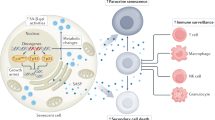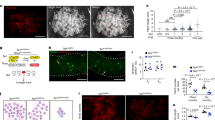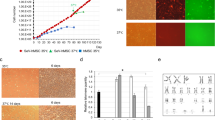Abstract
Reactivation of telomerase and stabilization of telomeres occur simultaneously during human cell immortalization in vitro and the vast majority of human cancers possess high levels of telomerase activity. Telomerase repression in human somatic cells may therefore have evolved as a powerful resistance mechanism against immortalization, clonal evolution and malignant progression. The comparative ease with which rodent cells immortalize in vitro suggests that they have less stringent controls over replicative senescence than human cells. Here, we report that Syrian hamster dermal fibroblasts possess substantial levels of telomerase activity throughout their culture life-span, even after growth arrest in senescence. In our studies, telomerase was also detected in uncultured newborn hamster skin, in several adult tissues, and in cultured fibroblasts induced to enter the post-mitotic state irreversibly by serum withdrawal. Transfection of near-senescent dermal fibroblasts with a selectable plasmid vector expressing the SV40 T-antigen gene resulted in high-frequency single-step immortalization without the crisis typically observed during the immortalization of human cells. Collectively, these data provide an explanation for the increased susceptibility of rodent cells to immortalization (and malignant transformation) compared with their human equivalents, and provide evidence for a novel, growth factor-sensitive, mammalian senescence mechanism unrelated to telomere maintenance.
This is a preview of subscription content, access via your institution
Access options
Subscribe to this journal
Receive 50 print issues and online access
$259.00 per year
only $5.18 per issue
Buy this article
- Purchase on SpringerLink
- Instant access to full article PDF
Prices may be subject to local taxes which are calculated during checkout
Similar content being viewed by others
Author information
Authors and Affiliations
Rights and permissions
About this article
Cite this article
Russo, I., Silver, A., Cuthbert, A. et al. A telomere-independent senescence mechanism is the sole barrier to Syrian hamster cell immortalization. Oncogene 17, 3417–3426 (1998). https://doi.org/10.1038/sj.onc.1202261
Received:
Revised:
Accepted:
Published:
Issue date:
DOI: https://doi.org/10.1038/sj.onc.1202261
Keywords
This article is cited by
-
Alternative Chk1-independent S/M checkpoint in somatic cells that prevents premature mitotic entry
Medical Oncology (2017)
-
Carcinogen-specific mutational and epigenetic alterations in INK4A, INK4B and p53 tumour-suppressor genes drive induced senescence bypass in normal diploid mammalian cells
Oncogene (2013)
-
Characterization of telomeric repeats in metaphase chromosomes and interphase nuclei of Syrian Hamster Fibroblasts
Molecular Cytogenetics (2012)
-
Telomeres and Telomerase Biology in Vertebrates: Progress Towards a Non-Human Model for Replicative Senescence and Ageing
Biogerontology (2005)
-
Identification of a ≦600-kb region on human chromosome 1q42.3 inducing cellular senescence
Oncogene (2003)



